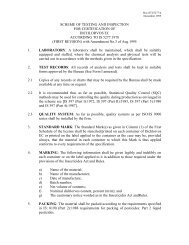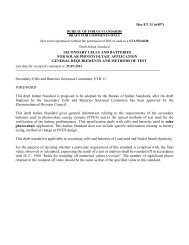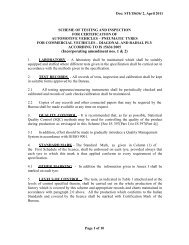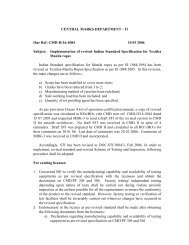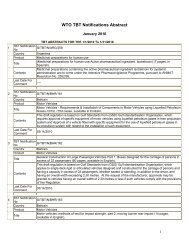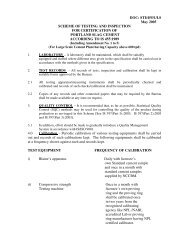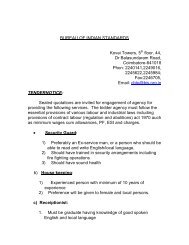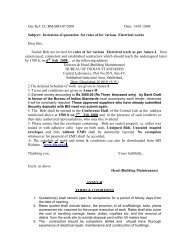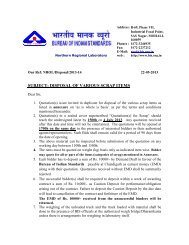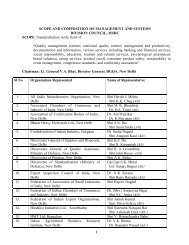यापक प रचालन मसौदे - Bis
यापक प रचालन मसौदे - Bis
यापक प रचालन मसौदे - Bis
You also want an ePaper? Increase the reach of your titles
YUMPU automatically turns print PDFs into web optimized ePapers that Google loves.
मानक भवन, 9 बहादरशाह ु ज़फर माग ,नई दली – 110002Manak Bhavan, 9 Bahadur Shah Zafar Marg,New Delhi – 110002ू__________________________________________________________________________________________दरभाष 23231282 Website: www.bis.org.in तार: मानकसंथाPhones 23230131 email: txd@bis.org.in Grams: Manaksanstha23233375 textiles.bis@gmail.com23239402 <strong>या<strong>प</strong>क</strong> <strong>प</strong><strong>रचालन</strong> <strong>मसौदे</strong>लेख ेषण संा<strong>प</strong>नहमारा संदभदनांकट एस 01/ ट–99 02-09-2013<strong>प</strong>रण क भौितक विधयॉं वषय सिमित, ट एस 01------------------------------------------------------------------------------------1 व वभाग सिमित के िच रखने वाले सभी सद य2 ट एस 01 के सभी सद य3 िच रखने वाले अ य सभी िनकायमहोदय ,कृ <strong>प</strong>या िन निलखत संल न लेख देखे :1) व ाद - व ाद लड़ क वषम<strong>प</strong>ता - धार व विध [ळेख: ट ए स 01(1167)]कृ <strong>प</strong>या इस मानक <strong>मसौदे</strong> का अवलोकन कर और अ<strong>प</strong>नी स मितयाँ यह बताते हए भेजे क यदुयह मसौदा राीय मानक के <strong>प</strong> म कािशत हो जाय तो इन <strong>प</strong>र अमल करने म आ<strong>प</strong>को यवसाय अथवाकारोबार म या कठनाइयॉं आ सकती ह ।स मितयॉंभेजने क अंितम ितिथ: 30-11-2013स मितयॉं, यद कोई हो तो कृ <strong>प</strong>या अधोह तार को उ<strong>प</strong>रिलखत <strong>प</strong>ते <strong>प</strong>र संल न ा<strong>प</strong> म भेज ।
यद कोई स मित ा त नहं होती है अथवा स मित म के वल भाषा संबंधी ुट हई ु तो उ<strong>प</strong>रो त लेख कोयथावत अंितम <strong>प</strong> दे दया जाएगा । यद स मित तकनीक र कृ ित क हई ु तो वषय सिमित के अ य के <strong>प</strong>रामशसे अथवा उनक इ छा <strong>प</strong>र आगे क कायवाह के िलए वषय सिमित को भेजे जाने के बाद लेख को अंितम <strong>प</strong> देदया जाएगा ।यह लेख भारतीय मानक यूरो क वैबसाइट www.bis.org.in <strong>प</strong>र भी उ<strong>प</strong>ल ध हैध यवाद ।भवदयसंल न : उ<strong>प</strong>रिलखत( भाकर राय )वैािनक ई एवं मुख (वाद)
मानक भवन, 9 बहादरशाह ु ज़फर माग , नईदली – 110002Manak Bhavan, 9 Bahadur Shah Zafar Marg, New Delhi –110002__________________________________________________________________________________________दरभाष ू 23231282 Website: www.bis.org.inPhones 23230131 email: txd@bis.org.in23233375 textiles.bis@gmail.com23239402DRAFT IN WIDECIRCULATIONDOCUMENT DESPATCH ADVICERef.DateTXD 01/T-99 02 09 2013PHYSICAL METHODS OF TESTS SECTIONAL COMMITTEE, TX 01INTERESTED MEMBERS OF TEXTILE DIVISION COUNCIL, TXDCALL MEMBERS OF TX 01ALL OTHER INTERESTEDDear Sir(s)Please find enclosed the following drafts:1) Textiles — Unevenness of textile strands — Capacitance method[Doc: TX 01 (1167)]Kindly examine this draft standard and forward your views stating any difficultywhich you are likely to experience in your business or profession, if this is finallyadopted as Indian Standards.Last date for Comments: 30 11 2013Comments, if any may please be made in the enclosed format and mailed to theundersigned at the above address or at textiles.bis@gmail.com or txd@bis.org.in orfaxed on 011-23231282.
In case no comments are received or comments received are of editorial nature,you will kindly permit us to presume your approval for the above document asfinalized. However, in case of comments of technical in nature are received then itmay be finalized either in consultation with the Chairman, Sectional Committee orreferred to the Sectional Committee for further necessary action if so desired by theChairman, Sectional Committee.The document is also hosted on BIS website www.bis.org.in.Thanking you,Yours faithfully,Encl : As above.(Prabhakar Rai)Scientist ‘E’ & Head (Textiles)
For BIS use onlyBUREAU OF INDIAN STANDARDS(Not to be reproduced or used as the Indian Standard without theprior permission of BIS)Draft for Comments OnlyDoc: TX 01 (1167)Draft Indian StandardTEXTILES — UNEVENNESS OF TEXTILE STRANDS —CAPACITANCE METHOD [DOC: TX 01 (1167)](Based on ISO 16549:2004) (ICS 59.060.01)NATIONAL FOREWORDThis Indian Standard is identical with ISO 16549:2004 ‘Textiles — Unevenness of textilestrands — Capacitance method’ issued by the International Organization forStandardization (ISO).Certain conventions are, however, not identical to those used in Indian Standards.Attention is particularly drawn to the following:a) Wherever the words ‘International Standard’ appears referring to thisstandard, they should be read as ‘Indian Standard’.b) Comma (,) has been used as a decimal marker while in Indian Standardsthe current practice is to use a point (.) as the decimal marker.In this standard intended to be adopted, reference appears to certain InternationalStandards for which Indian Standards also exist. The corresponding Indian Standardswhich are to be substituted in their place are listed below along with their degree ofequivalence for the editions indicated:International StandardISO 139 Textiles–Standardatmospheresforconditioning and testingCorresponding IndianStandardIS 6359:1971 Method forconditioning of textilesDegree of EquivalenceTechnically EquivalentIn reporting the results of a test or analysis made in accordance with this standard, if thefinal value, observed or calculated, is to be rounded off, it shall be done in accordancewith IS 2:1960 ‘Rules for rounding off numerical values (revised)’.
1 ScopeThis International Standard describes a method, using capacitance measuring equipment,for determining the unevenness of linear density along the length of textile strands.The method is applicable to tops, slivers, rovings, spun yarns and continuous filamentyarns, made from either natural or man-made fibres, in the range of 4 tex (g/km ) to 80ktex (kg/km) for staple-fibre strands and 1 tex (g/km ) to 600 tex (g/km ) for continuousfilamentyarns. It is not applicable to fancy yarns or to strands composed fully or partly ofconductive materials such as metals; the latter require an optical sensor (see A.4).The method describes the preparation of a variance-length curve, as well as thedetermination of periodicities of linear density. It covers also the counting ofimperfections in the yarn, namely of neps and of thick and thin places.Irregularities in the distribution of additives such as sizes, in moisture content and in fibreblending may increase the measured unevenness above its true value.2 Normative referencesThe following referenced documents are indispensable for the application of thisdocument. For dated references, only the edition cited applies. For undated references,the latest edition of the referenced document (including any amendments) applies.ISO 139, Textiles — Standard atmospheres for conditioning and testing3 Terms and definitionsFor the purposes of this document, the following terms and definitions apply.3.1unevennessvariation of linear density along the length of a continuous strand or yarnNOTE- The term is also used occasionally for the variation of yarn diameter.3.2coefficient-of-variation unevennessCV uvalue of unevenness (3.1) expressed as a coefficient of variationNOTE 1- The coefficient-of-variation unevenness is expressed in percent, for exampleCV u = 18,3 %.NOTE 2- See also 4.5 and 4.6.
3.3mean-deviation unevennessU uvalue of unevenness (3.1) expressed as an average mean deviationNOTE 1- The mean-deviation unevenness is expressed in percent, for example,U u = 14,6 %NOTE 2- See also 4.5 and 4.6.3.4capacitor lengtheffective length of the capacitor in the direction of the specimen movement, usually8mm to 20 mm3.5length betweenL blength of the test specimen for which the instrument takes an individual reading of massNOTE 1- The unevenness value decreases as L b is increased.NOTE 2- In the capacitance method, L b is normally the capacitor length but it can beincreased electronically.NOTE 3- L b is sometimes referred to in the literature as B.3.6length withinL wlength of the specimen for which an individual value of unevenness is determined and areading is givenNOTE 1- The unevenness value increases as L w is increased. When L w is more than 100m or so, then a further lengthening of L w increases CV u (or U u ) only slightly.NOTE 2- L w is sometimes referred to in the literature as W .3.7total measured lengthsum of all measured lengths L w3.8neptightly tangled knot-like mass of unorganized fibres3.9packageyarn wound to a shape, which may be supported (for example, bobbins, cones) orunsupported (for example, skeins, cakes), suitable for conditioning and testing
3.10spectrogramattachment to unevenness testers for the calculation and presentation of periodicvariations in the strand3.11thick placeyarn defect with linear density substantially (at least 50% ) greater than that of theadjoining segments of the yarn and extending for at least3.12thin placeyarn defect with linear density substantially (at least 50%) smaller than that of theadjoining segments of the yarn and extending for at least4 Principle4.1 A specimen is passed between two plates of a capacitor causing changes incapacitance which are proportional to the changes of mass of the specimen. Theinstrument evaluates these changes and reports them as CV u or U u .4.2 The fibre dielectric constant is also a factor determining the capacitance change. Aslong as the dielectric constant is unchanging (non-blended strands or perfectly uniformblending), the dielectric constant has no influence on the unevenness reading, whichdepends solely on the variation of mass. If the dielectric constant differs for the types offibres in a blend and if, at the same time, the blend is irregular, then the reading ofunevenness is increased above its true value. The interpretation of results thereforerequires caution.4.3 Several studies have been conducted over the years, see Reference [3] for example,comparing the true unevenness of a specimen, determined by cutting and weighing (seeA.3.1), with the reading from an unevenness tester. Good agreement was obtained, so thereadings from the tester can be taken as being the true unevenness value.4.4 The value of unevenness has meaning only if both L b and L w are known and theyshould, in principle, always be reported, preferably as CV u ( L b , L w ).EXAMPLE CV u (10mm, 1000 m).In practice, these two values are usually left unstated and are assumed to be those of themost commonly used unevenness tester, namely— L b : 8 mm for yarns, for rovings,20 mm for slivers and tops;— L w : total length of yarn on the package.4.5 There are two possible expressions for unevenness, CV u and U u . The U u is nowobsolete and its use, while permitted, is discouraged. CV u is the preferred expression.
4.6 If mass is distributed near to “normal”, then the ratio of CV u /U u is approximately1,25. This conversion factor must be used cautiously because, in case of departures fromnormality, the ratio can be considerably different. The conversion factor may be used toconvert a table of quality levels from U u to CV u .4.7 When CV u is plotted against L b , a “variance-length curve” is obtained which givesadditional information on the material's unevenness. When the plot is made on log-logpaper, then the curve is almost a straight line and its slope gives information on therelationship between short-term and long-term unevenness.4.8 Unevenness testers usually contain a spectrogram, which analyses the data andprovides information on periodic variations of linear density. This information is usefulin finding faults in the processing. The analysis uses an algorithm based on the Fouriertransformation.4.9 Unevenness testers usually contain a counter for yarn imperfections, namely neps,and thick and thin places. The level beyond which the imperfections are counted can beadjusted.4.10 Unevenness is a fundamental feature of yarn construction. It influences theefficiency of processing as well as fabric appearance. Lower unevenness generally resultsin a better-looking fabric but the relation is not simple and interpretation requires specialcare.5 Apparatus5.1 Different types of apparatus are in use for measuring strands made of staple fibres andfilament yarns.5.2 The apparatus consists of the following elements:a) Measuring device, featuring— several measuring condensers, usually grouped into one unit, for strands of varyinglinear density,— yarn guiding and pretensioning devices,— an adjustable-speed motor to advance the strand;b) signal processing unit, which— computes and indicates the values of CV u or U u and may also calculate the variancelengthcurve and present a graph of the periodic variations of linear density,— also counts the number of imperfections in most instruments. The unit shall be able tooperate at the threshold level of + 50 % , above which thick places are counted, andthe level of , − 50 % below which thin places are counted.— reports a reading for neps which shall be a product of the length, expressed inmillimetres, of the nep and the percent excess over the average linear density of
the yarn (for example, 4 mm× 50 %). The level of + 200 % , above which nepsare counted, shall be available.— other levels (for the three imperfection types) are also usually available;c) printer (optional), which provides a plot of the linear density of the strand;d) twisting device for testing untwisted or low-twist filament yarns. This device producesfalse twist in an untwisted or low-twist filament yarn, so that the yarn presents a nearlyround cross-section as it passes through the condenser. If the yarn passes through in a flatmode, there is the danger of adding variation depending on the way the flat yarn ispresented. The direction of the imparted false twist must be the same as that of any twistpresent in the yarn. The twisting device need not be used for the testing ofmonofilaments.5.3 To calibrate, use the procedure built into the instrument if possible. Alternatively, usea standard (usually tape) of known unevenness provided by the instrument manufacturerand follow the manufacturer's instructions. Finally, if the manufacturer's standard is notavailable, an in-house material of known and preferably low unevenness, may be used.6 Atmosphere for conditioning and testingThe standard atmosphere for preconditioning, conditioning and testing shall be asspecified in ISO 139. Assure that the total length of the material to be tested is inmoisture equilibrium. Conditioning for 24 h is usually sufficient for unsupportedpackages. Supported packages shall be conditioned for 48 h.7 Sampling7.1 Select laboratory samples in one of the following two ways:— according to a material specification, if available;— by agreement between the parties.7.2 The following minimum numbers of packages are recommended:— tops and slivers: 3 packages;— rovings: 4 packages;— staple-fibre yarns: 10 packages;— filament yarns: 5 packages.7.3 The material shall be unwound directly from the package during testing so as to avoidpossible deformation during handling.7.4 Test the number of specimens per package given in the material specification. If nospecification is available, test one specimen per package.7.5 Test the following lengths of test specimens. These are minimum values for the totalmeasured length.— tops and slivers: 50 m ;
— rovings: 100 m ;— staple-fibre yarns: 400 m ;— filament yarns: 400 m.8 Procedure8.1 Setting of the apparatusIf the tester allows a choice between a “normal” and an “inert” test, perform the “normal”test and then the “inert” if desired to establish the variance-length curve. The “normal”choice for some testers will result in the performance of both the “normal” and the “inert”tests automatically, so the setting can be to “normal”.8.2 Setting of the diagram scaleThe following diagram scale settings are recommended for most cases:— tops and slivers: ± 25 %;— rovings: ± 50 % ;— glass-fibre rovings: ± 100 %;— spun-fibre yarns: ± 100 %;— filament yarns: ± 10 % or 12,5 %.8.3 Selection of the condenser's measuring slotThe measuring ranges of the neighbouring slots overlap to some extent, so that certainspecimens can be tested in two slots, and the results may differ. Follow the instrumentmanufacturer's recommendation as to selection of slot for strands of a particular lineardensity.8.4 Selection of running speedThe following speeds are recommended. Other speeds may be used by agreement andshall then be stated in the test report.— tops and slivers : 25 m/min ;— rovings: 50 m/min;— yarns: 400 m/min.8.5 Guiding facilitiesBefore starting the test, adjust the guiding and tensioning devices to provide a pretensionwhich does not extend or otherwise distort the material. The specimen needs to passthrough the condenser without fluttering which would produce an error of measurement.8.6 Twisting deviceThread low-twist or untwisted filament yarns through the twisting device [see 5.2 d)].8.7 Plot representing the linear density along the strandSwitch on the drive of the printer, if used. Only a short length of the plot will be needed.8.8 Preliminary run
Old instruments may not stabilize their electronic measuring system automatically. Insuch cases, a preliminary run is recommended of approximately 20 % of the prescribedlength.8.9 Test runSet the feed in motion and observe that the passage through the condenser is smooth andundisturbed. Run the test until the indicated CV u or U u value is stable, or for a specifiedtime or length of strand, as mutually agreed.9 Calculations and expression of results9.1 If several packages were tested with one reading for each package, calculate theaverage CV u or U u value and, if required, the coefficient of variation of the individualvalues and the confidence limits. Round all results to the nearest 0.1 % .9.2 If desired, determine the variance-length curve. If the instrument does not give theCV u for long lengths, determine an additional CV u for long-term unevenness by cuttingand weighing, usually 100-m segments of yarn.9.3 Express the incidence of imperfections as the number per kilometre.9.3.1 Express the incidence of thick places as the number for which the linear densityexceeds the average linear density of the yarn by at least50 %. Counts at threshold levelsother than + 50 %, if used, shall also be reported.9.3.2 Express the incidence of thin places as the number for which the linear density isless than 50 % of the average linear density of the yarn. Counts at threshold levels otherthan - 50 %, if used, shall also be reported.9.3.3 Express the incidence of neps as the number which exceeds a reading of +200 %[see 5.2 b)]. Counts at a threshold reading of other than 200 %, if used, shall also bereported.NOTE A reading of+ 200 % is normally used for ring yarns and + 280 % for open-endyarns.10 Test reportThe test report shall include the following information:a) reference to this International Standard (ISO 16549:2004);b) date of the test;c) identification of the sample, including type of package;d) average unevenness value CV u or U u , in percent. If required, report also the individualresults, their coefficient of variation and 95% confidence limits;e) “length between”, L b , and “length within”, L w , if either differs from the usual values(see 4.4);f) graph of the variance-length curve, if determined;g) graph of the periodic variations, if determined;
h) a short length of the plot of the linear density along the strand, if determined;i) number of thick places, if determined (see 9.3);j) number of thin places, if determined (see 9.3);k) number of neps, if determined (see 9.3);l) threshold for thick places if other than + 50 % (see 9.3.1);m) threshold for thin places if other than − 50 % (see 9.3.2);n) threshold for neps if other than + 200 % (see 9.3.3);o) running speed, if different from those given in 4.4;p) any deviation in procedure from this International Standard.Annex A(informative)Other methods for the determination of unevennessA.1 Principles of test methodsThere are three methods for evaluating unevenness:a) visual assessment;b) measuring devices which determine the variation of the mass of the material or othercharacteristics proportional to mass. Capacitance-type testers are covered in the body ofthis International Standard. Methods by squeezing are referred to in A.3.2;c) measuring devices which determine the variation of the diameter of the material orother characteristics proportional to diameter. Optical methods are referred to in A.4;d) since no exact ratio exists between mass and diameter, the results determined frommethods A.1 b) and A.1 c) cannot be compared.A.2 Visual assessment (suitable for yarns)A.2.1 Yarn kept static and wound around a panelThe yarn is wound around a panel with specified winding density which depends on thelinear density of the yarn. The panel can be rectangular or trapezoidal and should be of acontrasting colour. Trapezoidal panels highlight short periodical irregularities in the yarnby producing a moiré effect. The panels are assessed visually using agreed upon lighting.It may be helpful to tilt the panel during assessment.For assessment use a comparison with standard materials or photographs. Alternatively,use agreed upon classification schemes or a verbal description of the observations.For documentation, the panel with the wound yarn may be stored. Taking photographs iscommon. Placing photographic paper directly on the sample during lighting has beenfound to be helpful for avoiding eye irritation.
The visual method is simple to apply and is used quite often, despite the subjectiveassessment procedure. Image-analysed systems and storing-and-evaluation systems maybe applied, if available.A.2.2 Running yarnContinuous unwinding and parallel grouping of rows of yarns allows visual observationof the running yarns by a test person, using appropriate lighting and a contrastingbackground. Verbal description of the observation is most often used and documentationof the test run is not possible.A.3 Determination of massA.3.1 Cutting and weighingThis is a laborious and time-consuming method, used for special purposes such asevaluation of unevenness testers or research. The material is cut into segments of lengthLb using appropriate equipment and the segments are weighed individually. Thecoefficient of variation of unevenness is calculated using the individualweights.Note the following relationships.a) length of cut, L b : As L b increases, the value of unevenness decreases.b) number of packages: If segments of different packages are mixed, increased variationis expected. For example, when testing neighbouring yarns out of a warp (large numberof packages), a higher variation results than for neighbouring yarns from a weft (smallnumber of packages).c) order of segments: The cut segments may follow each other consecutively or not (at aregular or non-regular distance). A tendency to larger variation is observed using the nonregulardistances; the results cannot be compared directly.A.3.2 Method using squeezing (applicable mainly to tops and slivers)The strand is guided into a test area where it is squeezed against a steady bottom roller orplate by a movable measuring device. The movement of the measuring device isregistered by mechanical or electrical means and is evaluated statistically.A.4 Optical methods (suitable for yarns)The evaluation of the unevenness of yarn diameter using optical means is expected toproduce an irregularity pattern similar to visual impression. The system is applied mainlyto the control of filament yarns or for conductive and wet yarns.The specimen is passed through an optical sensor (one or several systems of light sourcesand receivers). Optically distinguishable deviations of the diameter as detected by thesystem are registered by the receivers and can be evaluated statistically.
FORMAT FOR SENDING COMMENTS ON BIS DOCUMENT(Please use A4 size sheet of paper only and type within fields indicated. Commentson each clause/sub-clause/table/fig. Etc. be stated on a fresh box. Information inColumn 2 should include reasons for the comments and suggestions for modifiedwording of the clauses which the existing text is found not acceptable. Adherence tothis format facilitates Secretariat’s work)NAME OF THE COMMENTATOR/ORGANIZATION………………………………….DOCUMENT NO : [Doc :TX 01(1167)]BIS LETTER REFERENCE NO. : TX 01/T-99Item, ClauseSub-ClauseNo.Commentedupon (UseSeparate Boxafresh)CommentsSpecificProposal(Draft clause tobeadd/amended)Remarks(1) (2) (3) (4) (5)TechnicalReferences onwhich (2), (3),(4) are based



